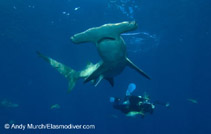| Family: |
Sphyrnidae (Hammerhead, bonnethead, or scoophead sharks) |
| Max. size: |
610 cm TL (male/unsexed); max.weight: 450 kg; max. reported age: 30 years |
| Environment: |
pelagic-oceanic; brackish; marine; depth range 1 - 300 m, oceanodromous |
| Distribution: |
Circumglobal in coastal warm temperate and tropical seas (Ref. 13562). Western Atlantic: North Carolina, USA to Uruguay, including the Gulf of Mexico and Caribbean. Eastern Atlantic: Mediterranean and Morocco to Senegal. Indo-Pacific: throughout the Indian Ocean; Ryukyu Islands to New Caledonia and French Polynesia. Eastern Pacific: southern Baja California, Mexico to Peru. Highly migratory species. |
| Diagnosis: |
Dorsal spines (total): 0-0; Dorsal soft rays (total): 0-0; Anal spines: 0-0; Anal soft rays: 0-0. A very large hammerhead also with a notch at the center of the head (Ref. 5578). Front margin of head gently curved in juveniles, becoming nearly straight in adults, with slight median notch (Ref. 26938). 1st dorsal fin very high and curved; 2nd dorsal and pelvic fins high and with deeply concave rear margins. Light grey or grey-brown above, white below; fins without conspicuous markings (Ref. 5578). |
| Biology: |
A coastal-pelagic, semi-oceanic shark, found close inshore and well offshore, over the continental shelves, island terraces, and in passes and lagoons (Ref. 244, 58302). Often bottom and reef associated at 1-80 m (Ref. 58302). Prefers to feed on stingrays and other batoids, groupers and sea catfishes, but also preys on other small bony fishes, crabs, squid, other sharks, rays, and lobsters (Ref. 244, 13562, 1602). A viviparous species, with 13-42 of about 56 to 70 cm young in a litter (Ref. 26938, 1602). Potentially dangerous to people (Ref. 13562) but only few, if any, of the attacks on people can be definitely attributed to it because of the apparent difficulty of distinguishing large hammerhead species involved in attacks (Ref. 244). Caught occasionally by target shark longline, demersal tangle net and tuna gillnet fisheries (Ref.58048). Meat utilized for human consumption (fresh, fresh-frozen, dried-salted, and smoked), liver oil for vitamins, fins for soup, hides for leather, and carcasses for fishmeal (Ref. 244). Its large fins, including the tail, sail-like first dorsal fin, are prized in the Oriental sharkfin trade (Ref. 47737). |
| IUCN Red List Status: |
Critically Endangered (CR); Date assessed: 09 November 2018 (A2bd) Ref. (130435)
|
| Threat to humans: |
other |
Source and more info: www.fishbase.org. For personal, classroom, and other internal use only. Not for publication.
